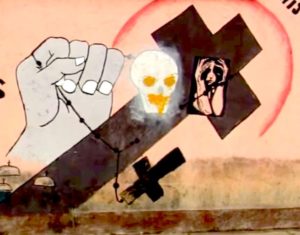
In Mumia Abu-Jamal’s newly-released book, Writing on the Wall: Selected Prison Writings (p. 223), he tells of Black Panther Kwando B. Kinshasa (of the New York Panther 21) doing time in the imperial U.S. army in Guatemala, but being politically radicalized there, too. It was the activists there that challenged him. They minced no words about the imperial force and brutality of U.S. power in their country – particularly against indigenous Maya and also against its working poor. Kinshasa returned to the U.S. city streets from Guatemala, knowing indeed that “the struggle is one” whether in the U.S. or abroad among colonized peoples.
The cover art for my book, The Executed God, is from the heart of Guatemalan indigenous peoples’ struggle against the U.S. and its brutal support of neoliberal globalization projects. The art is by survivors of a massacre of Maya peoples, a series of deadly assaults that were carried out to make way for the Chixoy mega-dam that was funded by the U.S.-backed World Bank and other economic forces.
Why would I use such art-work for the cover of a book on U.S. criminal (in)justice? One of the key arguments of the book is that resisting the penal state at home requires also a resistance to what U.S. imperial power does abroad. “Lockdown America” – the triad of U.S. police violence, mass incarceration and capital punishment/s – is integrally related to transnational policies of U.S. imperialism. Lockdown America is a domestic coalition of exploitation and repression that services the U.S. imperial pursuit of global sovereignty.
The U.S. police are implicated in multiple ways in U.S. structural violence abroad. U.S. police departments were key originators of the specific forms of torture that are used abroad by the CIA and other U.S. government security forces.[1] The U.S. Senate’s own investigations of 2014 have confirmed the CIA’s continued involvement in torture.[2] The police, with their legacy of torture tactics and outright violence – historically forged and emergent from U.S. slave patrols – often today remain on the front lines for surveillance, control, and dissemination of terror in poor communities.
U.S. security agents have themselves been torturers and have trained torturers of other nations’ security forces. This has often meant the presence of U.S. military personnel during acts of torture and also in supporting operations of forced removal that involve torture and massacre in displaced peoples who are deemed “in the way” of development or engaged in dissent to such development and U.S. geopolitical interests.[3]
The cover art of this book signals one site of U.S. power’s violent and brutal legacy. Yet the cover is also testimony to the power of indigenous peoples’ and others’ vision and resistance to that legacy. I first encountered this art when previewing a video about the massacre of the Maya for use in my course, “Empire & Capital,” which I teach at Princeton Theological Seminary. After some 20 years of periodic research and special focus on Guatemala, my continued reading of reports online surfaced the story of the Maya Achi’s massacre. It seemed a natural for a book that sought to present a creative and different interpretation of the cross of Jesus in relation to contemporary structural violence. The image connotes both genocidal suffering and a “fist” suggesting that somehow a resilient strength, some kind of fight back can rise in spite of – not because of – the slaughter.
The art is a key image from a mural in Pacux, Guatemala, a “model village” to which survivors of the massacre of some six hundred Maya Achi peoples were forcibly relocated. The 600 dead—107 children and 70 women—and their dislocation was the gruesome price they were forced to pay for construction of the Chixoy megadam in North-Central Guatemala of the late 1980s. Its construction by the U.S.-supported World Bank and Inter-American Development Bank required and then rationalized the destruction of the Maya community of Rio Negro. The mural wall, designed and painted by the grandchildren and children of the Chixoy Dam/Rio Negro massacre victims with thehelp of the extraordinary justice art collective H.I.J.O.S.[4] in Guatemala City, is emblazoned with the words, “La voz de los nietos e hijos nunca se olvida el terror” (“Our children’s and grandchildren’s voices will never forget the terror”).
Violated peoples do not forget. They dream alternatives and organize against overwhelming power. In the U.S., organized and creative resistance has an equally long history. In fact, this book is indebted to their long struggle. My thinking here would be impossible without their struggle, resistance and the many who have written to bear witness to their long-term efforts amid the ongoing genocide and repression. Indeed there is resistance and hope “from Ferguson to Gaza”. . . to Guatemala and beyond.
Next Excerpt: “What Do I Mean by ‘The Executed God’? “
______________
[1] Darius Rejali, Torture and Democracy (Princeton: Princeton University Press, 2009), 1-3, 239-42.
[2] U.S. Senator Diane Feinstein, “Senate Intelligence Study Committee Study on CIA Detention and Interrogation Program,” Released: December 8, 2014, http://www.feinstein.senate.gov/public/index.cfm?p=senate-intelligence-committee-study-on-cia-detention-andinterrogation-program, accessed June 20, 2015.
[3] Kate Doyle, “The Guatemalan Military: What the U.S. Files Reveal,” National Security Archive. George Washington University, June 1, 2000, and Kirsten Weld, Paper Cadavers: The Archives of Dictatorship in Guatemala (Durham and London: Duke University Press, 2015), 91-118. Jean-Marie Simon, Guatemala: Eternal Spring, Eternal Tyranny (New York: W. W. Norton, 1987), 79.
[4] H.I.J.O.S. (Hijos e Hijas por la Identidad y la Justicia contra el Olvido y el Silencio, “Children for Identity and Justice against oblivion and Silence”), http://upsidedownworld.org/main/guatemala-archives-33/1980–from-memory-to-resistance-children-bear-witness-hijoscelebrates-10-years-in-guatemala-, accessed June 30, 2015.